Each of the three jetcopters has a variable amount of weapon mounts that can be used for weapons.
|
Small Jetcopter
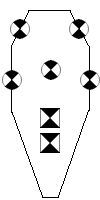
Front, side, under
two passive mounts
|
Standard Jetcopter
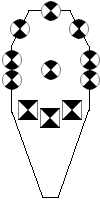
Front, nose, side, under
three passive mounts
|
Large Jetcopter
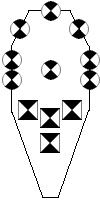
Front, nose, side, under
Four passive mounts
|
Front and nose weapon mounts may only accept forward firing weapons. Nose, side and under weapon mounts may mount heavy weapons, front weapon mounts may not. Passive mounts
may contain bombs. The under weapon mounts may contain a turret, and the nose mount may contain a nose turret, but in this case it loses it's ability to mount a heavy weapon. See
the equipment section for more details. Only side and under weapon mounts may be rear firing, but other equipment may change arcs of certain weapons to help this. Front mounts need not match each other.
Weapon mounts are standard weapon mounts, unless vertical swivel mounts are bought. This means that a jetcopter must be at the same altitude as the target.
 Jetcopters may carry cargo and passengers.
Jetcopters may carry cargo and passengers.
The small jetcopter has an occupancy of 4, driver and three passengers.
The standard jetcopter has an occupancy of 8, driver and seven passengers. A loss of passenger space will create a large cargo area.
The transport jetcopter has an occupancy of 20, driver and nineteen passengers. A loss of passenger space will create a large cargo area.
 Jetcopters are designed for passengers and cargo, so if you have the weight available, then you can include them in your vehicle. The small jetcopter will accept one gunner or
passenger, the standard and transport will accept up to two gunners and more passengers. Side gunners do not count against this gunner limit.
Jetcopters are designed for passengers and cargo, so if you have the weight available, then you can include them in your vehicle. The small jetcopter will accept one gunner or
passenger, the standard and transport will accept up to two gunners and more passengers. Side gunners do not count against this gunner limit.
 Very similar to the Simple System really, but giving a few more options. The technique is the same as that found in White Line Fever, and so you'll find the Jetcopter Performance Chart very useful for working out the speed and handling of your finished beast.
Very similar to the Simple System really, but giving a few more options. The technique is the same as that found in White Line Fever, and so you'll find the Jetcopter Performance Chart very useful for working out the speed and handling of your finished beast.
Use the Simple System for weapon mount allocation, standard armour allocation and initial handling.
| Carbon Steel | Carbon Plastic |
| Jetcopter | Cost | Weight | Cost | Weight | Stripped
Weight |
|---|
| Small | $75,000 | 1,000 | $100,000 | 800 | 600 |
| Standard | $110,000 | 1,500 | $150,000 | 1,200 | 900 |
| Large | $150,000 | 2,000 | $225,000 | 1,500 | 1,300 |
Factory stripped models are the same price as the basic models, but if retro-stripped, then it costs $10,000 for small and standard jetcopters, and $15,000 for large models.
 Armour for jetcopters costs and weighs and the same per location. This is due to the shape of the machine and the fact that the whole thing balances out in the end.
Armour for jetcopters costs and weighs and the same per location. This is due to the shape of the machine and the fact that the whole thing balances out in the end.
| Carbon Steel | Carbon Plastic |
| Jetcopter | Cost | Weight | Cost | Weight |
|---|
| Small | $2,000 | 35 | $5,000 | 20 |
| Standard | $3,500 | 50 | $8,000 | 35 |
| Large | $5,000 | 75 | $12,000 | 50 |
 Once a jetcopter size has been chosen, the actual design now needs to be decided. This cannot be retrofitted and each design has its own advantages and disadvantages. If no design is chosen, then the jetcopter is of a conventional layout - one main rotor and NOTAR stabilisers at the rear.
Once a jetcopter size has been chosen, the actual design now needs to be decided. This cannot be retrofitted and each design has its own advantages and disadvantages. If no design is chosen, then the jetcopter is of a conventional layout - one main rotor and NOTAR stabilisers at the rear.
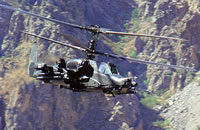
|

A jetcopter with co-axial rotors has two main rotors, one above each other, each rotating in opposite directions. This gives the jetcopter better stability and performance.
The co-axial design costs and weighs 10% of the basic jetcopter body type. It gives a +1 handling and +10 mph top speed. The jetcopter now has two main rotors and each must be armoured to gain any advantage, however, in all rotor critical checks.
|
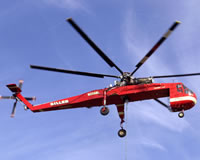
|

A heavy lift body design is built to carry external cargo and does this by sacrificing its entire internal cargo bay and enlarging the rotors slightly to produce additional lift. This does mean that the jetcopter loses a lot of weapon mounts and internal space but if you want to carry cargo, then nothing beats it.
The heavy lift body design is available for standard or large jetcopters only. The cost and weight remains the same (whilst sections are removed, other sections are reinforced). In addition, all side and under weapon mounts are lost. Passives are reduced to 2 (for all sizes). Occupancy drops to 2 - driver and passenger with no internal cargo capacity. Rotor radius is increased by 1 cm.
|
However, a heavy lift body may cargo externally slung cargo at a ratio of 5 weight of external cargo equalling 1 weight of internal space (thus if 100 weight of external cargo is carried, the craft is treated as if it is carrying 20 weight for performance purposes) - see below for more details. A heavy lift body may be combined with Tandem Rotors, co-axial rotors and Active Noise Control only, no other design types. If combined with Tandem Rotors, the externally carried cargo weight ration becomes 7:1 and the cost and weight if based on the heavy lift body not the base jetcopter.

|

This design - only available for standard or large jetcopters - adds a second main rotor, usually to the rear of the jetcopter (conventionally, but some designs place both rotors to each side of jetcopter). This does make the craft slightly slower and more cumbersome to fly, but it allows the craft to carry a much greater payload, which is ideal for transport aircraft because the tandem rotors are providing much more lift than usual.
The tandem rotor design weighs 15% and costs 10% of the basic jetcopter body type. The handling is reduced by 1 and in addition, the rotors make the jetcopters size increase to 24 cm square. A tandem rotor design may carry external cargo at the ratio of 5 weight of external cargo equalling 1 weight of internal space (thus if 100 weigt of external cargo is carried, the craft is treated as if it is carrying 20 weight for performance purposes) - see below for more details. |
Because the craft now has two rotors, it must buy armour for each of them for any benefit to occur. Finally, the counter size for the aircraft changes to its body length as a square.
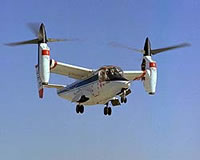
|

A tilt-rotor design splits the main jetcopter rotor into two smaller rotors which are extended onto wings that come out to either side of the craft. The rotors face upwards when operating in VTOL mode, but when flying the rotors tilt forward, much like that of an aircraft. The result is a jetcopter with better performance than normal, but also a craft that has smaller payload ability. In addition, the craft has a slightly different target matrix to account for the rotor placement.
A tilt-rotor craft costs and weighs 10% of the basic jetcopter body type. Having twin rotors means that the craft must buy double the amount of rotor armour for it to have any effect. The maximum payloads for tilt-rotor are as follows - small 2,500; standard 3,800 and large 5,500. However, a tilt-rotor craft has +20 mph and +4 mph acceleration.
|
On the Target Matrix, two changes need to be made. On the Front Facing chart, result 3 (Aerodynamics) becomes Rotors. On the Roof Facing chart, result 3 (Rotors) becomes Aerodynamics.
 Active Noise Control is not exactly a jetcopter type but a modification to existing designs, and like the above designs it cannot be retrofitted to a jetcopter. A jetcopter is loud with the majority of this noise coming from the rotors rather than the actual engines. However, there are ways to reduce this noise that includes changing the number of rotor blades, making the spacing between them uneven and making other operational configurations. This system of modulated blade spacing reduces the rotor noise by a large amount, making the jetcopter a truly quiet craft - no louder than that of a normal automobile. However, this stealth does come at a performance drop. Finally, unlike the movies, stealth cannot be turned on or off - it is always on.
Active Noise Control is not exactly a jetcopter type but a modification to existing designs, and like the above designs it cannot be retrofitted to a jetcopter. A jetcopter is loud with the majority of this noise coming from the rotors rather than the actual engines. However, there are ways to reduce this noise that includes changing the number of rotor blades, making the spacing between them uneven and making other operational configurations. This system of modulated blade spacing reduces the rotor noise by a large amount, making the jetcopter a truly quiet craft - no louder than that of a normal automobile. However, this stealth does come at a performance drop. Finally, unlike the movies, stealth cannot be turned on or off - it is always on.
Buying Active Noise Control doesn't add any weight to a jetcopter, but does cost 20% of the base jetcopter body cost and 20% of any above design modifications (so a standard tilt-rotor jetcopter with ANC will cost 20% of $110,000 and 20% of $11,000 for a total of $24,200). The craft loses 15% of its top speed and acceleration (rounded down, calculated after all other modifications for speed, such as design, chargers etc).
Actual Dark Future game rules can't really be given here as Active Noise Control will not really come into play much in a standard duel - if you can see the target, you're not worried about what it sounds like - but it could be used to hide a jetcopter around a large rock outcrop, especially if the enemy are approaching in vehicles. Active Noise Control is more of a role-playing tool, handy if you want to create "black helicopters" that can secretly spy or creep up on players...
 This equipment is good for both systems, so if you have the money and the weight, go right ahead and use. All jetcopters have the ability to haul cargo internally.
This equipment is good for both systems, so if you have the money and the weight, go right ahead and use. All jetcopters have the ability to haul cargo internally.
 All normal engine modifications from White Line Fever are allowed in a jetcopter, and they cost and weigh the same, as well as performing the same too.
All normal engine modifications from White Line Fever are allowed in a jetcopter, and they cost and weigh the same, as well as performing the same too.
 Autopilot:
Autopilot:
An autopilot does the same job as active suspension does for a car. It is a computer controlled piloting system, which constantly monitors the atmospheric conditions,
streamlining and condition of the jetcopter and then adjusts various control surfaces and systems to give a better, smoother ride for the occupants.
It increases a jetcopters handling by +2, costs $15,000 and weighs 40.
 Robopilot:
Robopilot:
The robopilot is the next stage up from the autopilot, and is essentially robotic drive for a jetcopter. Like robotic drive, the jetcopter must have an autopilot first.
It gives +3 handling (in total), costs $18,000 (in total) and weighs 60 as a complete package. An upgrade from an autopilot costs $12,000 and weighs 20 above the base cost of the autopilot.
 Side Gunner:
Side Gunner:
For that authentic Soviet 'Nam feel, side gunners are available who will lean out the side of your jetcopter and fire the weapons for you. Very similar to cupola or pintle
gunners, and as vulnerable to fire too. Only one is allowed per side, despite the fact that there are two side mounts on some jetcopters, and small jetcopters may not have any.
 The cost is $5,000 per gunner, $10,000 for the mount, and they weigh 100 for the gunner, and 75 for the mount. Then you must include the cost and weight of the weapon as
well. The arc of fire for side gunners is the same as that for motorcycle pillion riders (see Street Fighter for details), but also the weapon is considered to be a vertical swivel mount for no extra cost. Side gunners may mount heavy weapons. Side gunners are vulnerable, and can be hit by driver/crew hits and are hit by any critical hit to the side of the jetcopter containing the gunner. As with tail gunners, when this happens, roll 1d6. On an even result, the gunner is hit, on an odd result, the weapon is hit.
The cost is $5,000 per gunner, $10,000 for the mount, and they weigh 100 for the gunner, and 75 for the mount. Then you must include the cost and weight of the weapon as
well. The arc of fire for side gunners is the same as that for motorcycle pillion riders (see Street Fighter for details), but also the weapon is considered to be a vertical swivel mount for no extra cost. Side gunners may mount heavy weapons. Side gunners are vulnerable, and can be hit by driver/crew hits and are hit by any critical hit to the side of the jetcopter containing the gunner. As with tail gunners, when this happens, roll 1d6. On an even result, the gunner is hit, on an odd result, the weapon is hit.
 Nose Turret:
Nose Turret:
Instead of being permanently fixed forward, a nose weapon mount may contain a special turret that changes the arc of fire considerably. A nose turret has an arc of fire equalling
that of a front firing trike pintle mount (White Line Fever, pg. 38).
A nose turret costs $15,000 and weighs 100. It may not mount heavy weapons, but may have a turret computer bought for it. It is treated in all respects as a normal turret.
Total vertical swivel mounts may be bought for the nose turret.
 90 degree Side Mount:
90 degree Side Mount:
For side-mounted weaponry only, this changes the weapons fire arc from forward or back to a 90-degree pintle mount to the side of the jetcopter. It costs $8,000, and weighs 25 per weapon with an arc of this type.
 Crash Suppression and Passenger Cages:
Crash Suppression and Passenger Cages:
These may be bought for jetcopters as normal, but remember that each person in a jetcopter who needs the protection must have it bought for them.
Crash suppression doesn't work for side gunners, and passenger cages have a limited effect. Whenever the side gunner is hit, roll 1d6. On a 5 or 6, the shot is soaked up by
the passenger cage.
 Rotor Armour:
Rotor Armour:
The rotors are a vital part of a jetcopter, and without them, the machine will crash and burn. As such, rotor armour is a very vital safety component. It costs $10,000 for the
small and standard jetcopters, $12,000 for the large jetcopter, and weighs the same as one point of carbon steel armour.
Whenever the jetcopter takes a rotor critical, roll 1d6. On an even result, the critical is soaked up by the armour, on an odd result, the critical takes place.
 Reinforced Landing Gear:
Reinforced Landing Gear:
Landing gear is also an important part of a jetcopter, and one without them will find themselves in great trouble. For $10,000 and weight 30, the jetcopter can have an
reinforced landing gear. This has a double feature in that it protects the gear from critical damage (roll 1d6, even results saves against the critical, odds let it stand) and allows the jetcopter to land on unprepared and rough landing strips in the middle of nowhere.
 All the normal range of weaponry is open for use by jetcopters.
All the normal range of weaponry is open for use by jetcopters.
Contrary to popular belief, jetcopters may use and mount passive weapons, and all the normal range of weapons are available. However their use is very limited - the jetcopter
must be at NOE altitude only. Although they can be used (to a limited extent) as an anti-jetcopter weapon - see the Jetcopter Combat section for further details.
Bombs may also be used by jetcopters, and these may only be dropped in passive mounts. One large bomb or two small bombs may be carried per passive mount.
 A jetcopter can carry cargo in two locations - either internally or under-slung externally. In either case, the total amount of cargo carried counts against the jetcopters performance. So if a TV Jetcopter was to carry 1,000 weight worth of under-slung cargo, it would be treated as a weight 3,480 jetcopter with all relevant performance drops. The reason for being able to carry under-slung cago is that space itself is not an issue. Only a large jetcopter can carry cars within its body, but any jetcopter can carry one under-slung if it has sufficient power.
A jetcopter can carry cargo in two locations - either internally or under-slung externally. In either case, the total amount of cargo carried counts against the jetcopters performance. So if a TV Jetcopter was to carry 1,000 weight worth of under-slung cargo, it would be treated as a weight 3,480 jetcopter with all relevant performance drops. The reason for being able to carry under-slung cago is that space itself is not an issue. Only a large jetcopter can carry cars within its body, but any jetcopter can carry one under-slung if it has sufficient power.
Two ways of carrying more cargo include using tandem rotors and a heavy lift body. The heavy lift body is simply lighter whilst the tandem rotor design actually allows all externally carried cargo to be carried at one-tenth its normal weight. So if the TV Jetcopter was of a tandem rotor design then the 1,000 weight would actually only count as 200 for performance loss. On no account can a jetcopter carry more weight than the Jetcopter Performance Chart allows, which is where the tandem rotor design really comes into its own.
A jetcopter with under-slung cargo does have some movement notes and combat points to consider.

